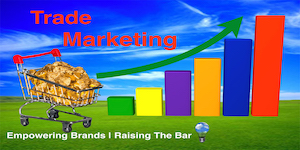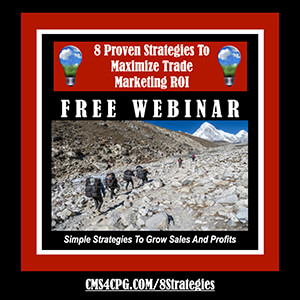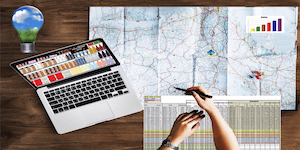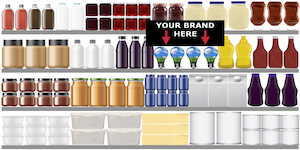What is trade marketing and what are the benefits of trade marketing?
Trade marketing includes everything required to get your product in the hands of a shopper. It is the primary growth driver for all CPG brands. The goal of every promotion is to introduce your product to new shoppers – period! The challenge is that while about 25% of our brand's gross sales are tied to their trade marketing, over 70% of those dollars or wasted by promotions that are ineffective, more in natural.
Want proven strategies to reduce wasted spending, more accurately plan and forecast, confidently grow, and scale your brand?
It begins with maximizing your trade marketing ROI.
The real question should be how do you affectively grow a brand when so many of your promotional dollars do a little if anything to drive sustainable sales. This is something that literally every brand struggles with, including big brands. The difference is, that big brands typically have much deeper pockets and therefore they have a significant competitive advantage.
Let's level the playing field.
There IS a better way!
Retail is pay to play. Trade marketing is typically the single largest line item on a company's income sheet. Distributors and retailers  demand that brands promote their products and customers to expect them. So how can a small disruptive natural brand compete head-to-head with larger more sophisticated brands? The answer is by more effectively managing your trade spending, laser targeting your ideal shopper, and with creative disruptive strategies, others overlook.
demand that brands promote their products and customers to expect them. So how can a small disruptive natural brand compete head-to-head with larger more sophisticated brands? The answer is by more effectively managing your trade spending, laser targeting your ideal shopper, and with creative disruptive strategies, others overlook.
The result is an effective marketing driving traffic to increase brand awareness. The result is converting occasional customers into loyal evangelists. The benefit is increased profit margins from trade promotions, more runway to confidently grow and scale your brand, better evaluations and higher returns for investors, more resources to support worthy causes that align with your shoppers, and much much more.
Interested in learning more?

8 Proven Strategies To Maximize Trade Marketing ROI FREE webinar
Retail is pay to play. Trade marketing represents everything required to get your product into shopper's hands. It is typically the single largest line item on a company's income sheet representing about 25% of your gross sales and yet over 70% is wasted, more in natural. Would you like to know proven strategies to reduce wasted promotional spending and gain a competitive edge, even with big brands? That's the focus of this free webinar. YOU DON'T WANT TO MISS IT! Click here to watch it!
Trade Promotion ROI Calculator
Click here to access the Trade Promotion ROI Calculator
The future of trade marketing must place the shopper first. Not as a cheap slogan but as the focus of your modern trade strategy beginning with your purpose and how that aligns with the retailer's objectives.
There are a lot of things to consider when putting together effective trade marketing campaigns. Let's begin with the buyer persona or brand avatar. Most brand marketing strategies ten to commoditize the shopper, meaning that they tend to group shoppers into common buckets. This overlooks the brand's target audience and target market. This is the challenge of using traditional customer data, content marketing, and digital marketing methods.
Natural shoppers don't want to be sold, they want products that meet their specific needs. They are no clones and they object to being categorized as such. Core natural shoppers want that they want. They want products that align with their values that deliver exceptional value, something I proved in the feature article I wrote for the 2016 Category Management Handbook. I learned that natural organic products are responsible for all the sustainable growth across every channel and across every category. In their absence sales are down or declining. This is exactly why I launched my free Turnkey Sales Story Strategies Course to teach brands how to personalize their shopper marketing and bake it into their brand story. It teaches you how to perform market research in your target market by having one-on-one conversations with actual customers. This allows you to integrate their messaging into your brand story.
categorized as such. Core natural shoppers want that they want. They want products that align with their values that deliver exceptional value, something I proved in the feature article I wrote for the 2016 Category Management Handbook. I learned that natural organic products are responsible for all the sustainable growth across every channel and across every category. In their absence sales are down or declining. This is exactly why I launched my free Turnkey Sales Story Strategies Course to teach brands how to personalize their shopper marketing and bake it into their brand story. It teaches you how to perform market research in your target market by having one-on-one conversations with actual customers. This allows you to integrate their messaging into your brand story.
The goal here is to help you navigate the complexities of trade marketing and help you avoid the pitfalls other brand owners fall into. I will be your guide on this journey, your sherpa.
An effective trade marketing strategy begins with being effective promotion analysis.
Tired of feeling like an ATM machine?
Your success begins with being able to effectively measure your promotional effectiveness. This is how you maximize each and every selling opportunity.
This is why most promotions fail and how to avoid throwing money away. Most brands struggle to measure and evaluate promotional effectiveness. This does not need to be overly complicated. This critical skill determines how long your brand will be around, months, years, or longer. Learn the basic skills to drive profitable sales.
Would you like a cool tool to analyze your promotions?
Free Trade Promotion ROI Calculator
It's free. My gift to you!
Click here to access the Trade Promotion ROI Calculator
Another challenge is that current marketing tools over-promise and over-deliver. I like to compare them to QuickBooks, a product I use, and love. I studied to become a CPA in college and I can promise no account program will automatically elevate you to that status. The same is true with the current method of trade marketing. Garbage in, garbage out. There is a lot more to an effective trade marketing strategy than any push-button solution. In fact, they might even create additional issues without having a thorough understanding of trade marketing strategy and marketing disciplines. My Trade Marketing Essentials Course will delve into this in detail.
 Most promotions are ineffective and fail to encourage new shopper trials, the primary goal of every promotion. While rewarding loyal shoppers to make repeat purchases can prove beneficial, new shopper engagement is the key to growing brand sales. More importantly, effective promotions help retailers compete more effectively by driving shopper traffic into their stores and away from their competition. This is the greatest bargaining chip any brand can offer a retailer. Savvy brands leverage their ability to drive retailer sales when they negotiate with retailers for premium shelf space, incremental merchandising opportunities, etc.
Most promotions are ineffective and fail to encourage new shopper trials, the primary goal of every promotion. While rewarding loyal shoppers to make repeat purchases can prove beneficial, new shopper engagement is the key to growing brand sales. More importantly, effective promotions help retailers compete more effectively by driving shopper traffic into their stores and away from their competition. This is the greatest bargaining chip any brand can offer a retailer. Savvy brands leverage their ability to drive retailer sales when they negotiate with retailers for premium shelf space, incremental merchandising opportunities, etc.
What is the difference between marketing and trade marketing?
A marketing manager typically helps a brand align the value proposition with its target audiences. This begins with market research to help you identify your buyer persona – your customer avatar. Shopper marketing helps increase brand awareness – the goal of all marketing campaigns. Shopper marketing is one of the most effective tools in a brand's business development strategy. It includes shopper survey insights that help validate the brand's product proposition from the shopper's perspective. It answers the questions of who buys your products and why they buy your products.
Brands frequently use sales incentives to help sell your product and keep customers from buying your competitor's product. Some of the tools brands use are social media, shopper marketing data, digital marketing, and content marketing.
Trade marketing includes all of the above but is more focused on the execution of the marketing campaigns. This requires the brand to focus on goal setting – what are the sales growth strategies or objectives for the brand. Trade promotions encompass everything from your products launch, your brand engagement strategy, increasing sales, and scaling your brand. Some of the retail execution included merchandising and managing your shelf space.
focus on goal setting – what are the sales growth strategies or objectives for the brand. Trade promotions encompass everything from your products launch, your brand engagement strategy, increasing sales, and scaling your brand. Some of the retail execution included merchandising and managing your shelf space.
It is the responsibility of wholesalers and distributors and retailers to manage the promotional strategies for their private label products. It's important that your trade marketing campaign does not compete with private label promotions. The goal of every effective trade marketing campaign is to encourage shoppers to choose your brand over private label and your competitors product. Make it easy to say yes to your brand!
Here are eight simple strategies to maximize your Trade Marketing ROI.
1. Creativity
Most companies repeat promotions annually in addition to copying competitor promotions. Companies that have creative strategies typically have greater success in growing sustained sales. Effective promotions encourage incremental and impulse purchases. Co-promote within the brand and with complementary items (such as chips and dip) when possible. The ultimate goal is to increase consumer purchases after the promotion ends. This occurs when new customers become committed to loyal shoppers.
typically have greater success in growing sustained sales. Effective promotions encourage incremental and impulse purchases. Co-promote within the brand and with complementary items (such as chips and dip) when possible. The ultimate goal is to increase consumer purchases after the promotion ends. This occurs when new customers become committed to loyal shoppers.
Another strategy is to partner with other complementary brands, things shoppers typically purchase along with your brand. Multiple brands working together to market your products can dramatically explode sales.
2. Purpose
Every promotion should have a well-defined and understood purpose. Design promotions around opportunities to build your brands such as important causes (Earth Day, back-to-school, etc) and product demos. Don't promote to give your product away. My favorite example is a large potato chip manufacturer that continually has BOGO's (buy one get one free) during the major sporting events and on holidays and occasions consumers would probably pay a premium. Category leaders should instead schedule deep promotions when category buying is low.
3. Consistent brand messaging
Most promotions fail to connect with shoppers. Build a strategy around your consumer's specific needs and wants. Communicate a consistent message across all marketing vehicles by integrating sales strategies through different mediums including and especially social media.
4. Plan ahead
Be prepared to support the promotion by having additional products on hand. Use advanced category management principles to accurately predict sales increases and to identify the ultimate promotion price point. Out-of-stocks are a huge problem for some brands. Never miss a sale due to poor planning on your part. Also, a few cents off in either direction can dramatically affect consumer take away. It is the brand's responsibility to keep shelves full and shoppers happy throughout the promotion.
accurately predict sales increases and to identify the ultimate promotion price point. Out-of-stocks are a huge problem for some brands. Never miss a sale due to poor planning on your part. Also, a few cents off in either direction can dramatically affect consumer take away. It is the brand's responsibility to keep shelves full and shoppers happy throughout the promotion.
5. Strong brand building strategy
Promotions that don't grow category and brand sales after the event ends are a huge waste of resources and money. Set specific goals and objectives for each promotion, then evaluate promotions afterward to highlight successes and/or missed opportunities. Account for all costs including deductions, retailer fees, scan down rate, bill back, missed sales due to out-of-stocks, off-invoice rebates, menu fees, fixed costs, forward buys, and miscellaneous costs when evaluating promotion effectiveness. Include retail, distributor, broker, and supplier execution in your evaluation.
6. Promotion schedule
Some companies have very predictable promotion schedules that train customers to purchase their brand only when they are on sale. While it's nice to reward consumers for being loyal, the goal of all promotions is to encourage shoppers to be loyal and to invite new customers to try your products. Learn your competitors strategies and the effectiveness of their promotions. Build your strategy around their promotional efforts to maximize every opportunity to invite their shoppers to try your brand.
While it's nice to reward consumers for being loyal, the goal of all promotions is to encourage shoppers to be loyal and to invite new customers to try your products. Learn your competitors strategies and the effectiveness of their promotions. Build your strategy around their promotional efforts to maximize every opportunity to invite their shoppers to try your brand.
7. Efficient trade fund management
This can be one of the most difficult areas to effectively manage due to the complexity of differing retailer programs and systems. Identify and adopt systems that allow you to effectively manage trade spending, cash flow across simultaneous promotions at multiple retailers, promotion reconciliation, deductions, and promotion analysis and inventory movement throughout the supply chain. Integrate your system with retailer and market data to maximize your results.
8. Pay on scan
Promotions can be set up in a lot of different ways. The most effective way to manage promotions and improve your ROI is to pay for what shoppers purchase. The way this works is to set up promotions that reimburse retailers for items scanned through their registers. This is far better than paying a lump sum and taking a chance that the retailer may not help you drive sales at every location.
Ready to take your trade marketing to the next level and beyond?
Trade Marketing Essentials is your blueprint for mastering promotional effectiveness. Click here to learn more and why this matters.